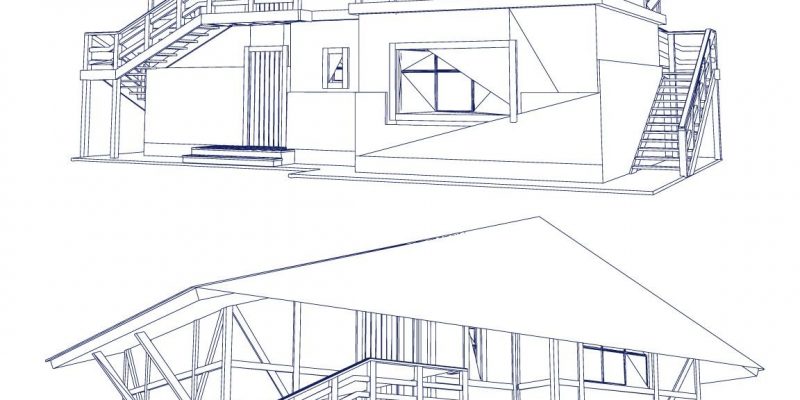Introduction:
Construction lines are an essential part of the design process used in architectural & engineering projects. When it comes to the construction of buildings, constructions, as well as other items, serve as the basis for achieving precision. Construction Lines Drawing are essential in producing a final product that conforms to the requirements outlined in the design. Their functions range from ensuring accuracy to organizing the fundamental framework.
In this piece, we will discuss the function of construction lines, their significance, the various kinds of construction lines utilized during the design process, and the significant part that these lines play in the production of a final product that is precise and accurate. This article will provide essential insights into the development of construction lines and their crucial function in the design process, whether you are an architect, an engineer, or simply interested in building and design.
Construction Lines Definition
Temporary lines that are drawn on a layout or plan to represent the fundamental framework and form of a building, item, or structure are referred to as construction lines. Other names for construction lines include reference lines and layout lines. They are utilized to assist in the visualization and communication of the design by the engineers and architects, as well as the verification of the accuracy and consistency of the layout. These lines act as a guide for placing elements like walls, columns, and windows, as well as for defining the shape and size of the final product. They also serve as a guide for determining the overall dimensions of the product.
In most cases, Construction Lines Art is drawn with a pencil, and once the design has become finalized and work has begun on the structure, the pencil is erased. They contribute significantly to the design process, playing an essential part in ensuring that the final product is produced according to the appropriate specifications and that it is up to an acceptable level of quality.
Purpose & Importance of Construction Lines
Accuracy, communication, & efficiency are the three primary benefits of using construction lines, which help explain their purpose and significance.
· Accuracy:
During the design stage, construction lines are both a reference and a guide. They assist architects and engineers in the process of laying out the fundamental structure of the object & ensuring that all components are aligned and spaced appropriately. The use of construction lines allows designers to immediately identify and remedy any faults or inconsistencies in the design; this significantly reduces the likelihood that mistakes will be made during the construction process.
· Communication:
Construction Lines Blender offers a graphical representation of the design, which assists in conveying to other members of the design & construction stages the desired organization of the object’s components and structure. They also act as a benchmark for contractors, which enable those individuals to quickly comprehend the design and construct the construction by the standards that have been specified.
· Efficiency:
The use of construction lines helps to simplify the conceptual design & saves time, and allows engineers and architects to make modifications and modifications to the design more quickly and easily. This saves time and helps to streamline the overall construction process. It is much easier to ensure that the final product will satisfy the specified specifications and criteria if it is possible to make adjustments to the design rapidly and straightforwardly.
Importance of Construction lines
Construction lines are an essential component of engineering and architectural drawings since their primary purpose is to act as a map or reference point during the manufacturing process of the end product. They are used to specify the relationships between the various aspects of the design, such as the place of objects, the angles of curves, as well as the orientation of the layout. For example, the position of items, the curves’ angles, and the layout’s orientation.
Because they offer the designer a reference that is unmistakable and straightforward to comprehend, construction lines are an invaluable tool in achieving high levels of accuracy & precision in the drawing. They can be utilized to examine the design dimensions, ensure that the components are correctly aligned & spaced, as well as verify that the design is by the initial specifications.
The Construction Lines Solidworks can be used to make multiple design repetitions. This allows the designer to experiment with a variety of different configurations & layouts before committing to the final version of the design. Because of this, the design process may be more iterative and efficient, as the designer can modify and adjust the design with relative ease and speed.
In a nutshell, construction lines are an essential tool for design and engineering, as they offer an understandable and precise point of reference for making the finished product. They help streamline the conceptual design and play an essential role in ensuring its quality, precision, and consistency. Additionally, they contribute to the overall efficiency of the design process.
Different Categories of Building Lines
· Reference Lines:
Reference lines, also known as baselines or datum lines, provide a point of reference for placing other elements within the design. Other names for reference lines include datum lines and baselines. They are utilized to align and place objects, as well as to guarantee that there is adequate spacing between the objects. When beginning the design process, it is common practice to begin by drawing reference lines in a perpendicular direction to the ground.
· Center Lines:
The location of an item’s or structure’s center can be determined using center lines. They are frequently used in aligning and positioning features, such as doors and windows, and dividing an object into equal pieces. The center lines of a design can be horizontal or vertical, but either way, they ensure that the overall composition is symmetrical & balanced.
· Dimension Lines:
Dimension lines are typically utilized to indicate the shape and size of a construction or object. They are employed as a reference for measuring & determining the exact size of the product, and they are utilized to ensure that the design adheres to the necessary criteria. Dimension lines are drawn parallel to the object they are being used to measure and are accompanied by dimension text indicating the measurement.
· Cutting Lines:
Cutting lines, also known as section lines, graphically represent a cut or cross-section through an object or structure. Cutting lines can also be called section lines. They are utilized to provide a comprehensive understanding of the structure and design of an object, as well as to reveal the inside intricacies of an object. Cutting lines, which are often depicted as dashed lines, denote the piece of the object being viewed in the section and are used in most drafting applications.
· Hatching Lines:
The use of hatching lines, often referred to as fills lines, is intended to identify regions of the design that are to be filled in or shaded. Both are utilized in these capacities to visually display the various components and aspects of the thing and depict materials like concrete or wood. Typically, hatching lines are drawn in a pattern, and their primary purpose is to fill in regions precisely and uniformly.
Usage of Construction Lines in the Design Process
· Conceptual Design:
During the conceptual design stage, construction lines map out the fundamental structure and form of the designed object. They assist architects and engineers in visualizing and experimenting with various design ideas and making alterations and revisions to the design as required. At this stage, the first chance to discover and repair any mistakes or contradictions in the design and to ensure that the basic layout satisfies the relevant specifications and standards can be taken advantage of.
· Detailed Design:
During the detailed design stage, the design is refined and perfected with the help of construction lines. They are utilized to ascertain the precise shape and size of the thing and ensure that all components are aligned and spaced appropriately. At this step, it is essential to ensure that the final design satisfies the intended criteria and needs and that all parts, including walls, windows, & doors, are positioned in the appropriate locations.
· Construction Documentation:
During the construction documentation stage, the final design is communicated to contractors and other members of the contracting firm through the use of construction lines. They are used to verify that the construction process is carried out by the specifications that have been set, and they give a clear depiction of the desired layout & structure of the thing. This stage is essential to verify that the finished product satisfies the specified standards and specifications to be considered successful.
· Construction
During the building process, construction lines serve as a point of reference and guide for positioning pieces and establishing the shape and size of the finished result. They are utilized to verify that the building is constructed by design envisioned for it and to discover and rectify any flaws or inconsistencies that may develop while the project is being created.
The Importance of Proper Use of Construction Lines
· Minimizing Errors:
When used correctly, construction lines can assist in reducing the number of mistakes made during the design and building processes. Architects and engineers can ensure that the building is constructed by design intended for it if they use reference lines, center lines, and dimension lines, cutting lines, & hatching lines in the appropriate manner. Using construction lines enables any errors or inconsistencies to be spotted and addressed at an earlier stage of the process, which, in the long run, can result in time and material savings.
· Ensuring Accuracy:
Construction lines are essential to maintaining precision throughout the design and building process. They serve as a transparent reference and guidance for the arrangement of elements, as well as for establishing the dimensions and contours of the final product. Architects and engineers can verify that a structure is built according to the desired specifications so that all components are correctly aligned & spaced by appropriately utilizing construction lines.
· Meeting Design Specifications:
Utilizing construction lines correctly helps ensure that the end product satisfies its design parameters and quality standards. Architects and engineers can effectively convey their design intentions and make sure that the resulting building is created according to the specified parameters when they use reference lines, center lines, and dimension lines, cutting lines, & hatching lines in the appropriate manner. This reduces the likelihood of errors occurring throughout the building process, allowing for the development of structures and things that are precise, effective, and of superior quality.
Review of the Most Important Facts:
Construction lines are an essential instrument in the whole process of building design and construction. They are used as a guide and a reference for architects, engineers, & contractors and their primary purposes are to ensure correctness, minimize errors, and satisfy design criteria and standards.
There are many distinct kinds of construction lines, such as reference lines, center lines, dimensions lines, cutting lines, & hatching lines; each line type has a unique function and application. It is essential to use construction lines appropriately to guarantee that the finished product will be of high quality and conform to the intended standards and requirements.
Final Thoughts on the Importance of Construction Lines in the Design Process:
Construction lines are an essential component of the design and building processes, as they provide the basis upon which precision and accuracy are built. They offer a straightforward reference and guide for architects, engineers, & contractors, which helps reduce the likelihood of mistakes during the building process.
It is impossible to exaggerate the significance of correctly utilizing construction lines. Doing so is essential to ensuring that buildings and other items are constructed quickly, accurately, and by the specified criteria.
Recommendations for Further Reading and Research:
There are a variety of materials accessible to people who have an interest in gaining a deeper understanding of construction lines as well as the role they play in the design process. Books, blogs, & online courses offer in-depth information on the many types of construction lines, their applications, and the best methods for effectively using them.
In addition, working with experienced engineers and architects can provide beneficial insights and hands-on knowledge regarding the appropriate utilization of construction lines throughout the design and construction process.
Conclusion
The Introduction to Construction Lines offers readers a complete explanation of the significance of construction lines in the procedure of both building design and building construction. Architects, engineers, & contractors can construct buildings and items that are accurate, efficient, and of high quality, provided they have a solid understanding of the various types of construction lines, their purposes, and the best techniques for using them correctly. Effective use of construction lines contributes to establishing a precise and accurate foundation throughout the design and construction process.














Comments